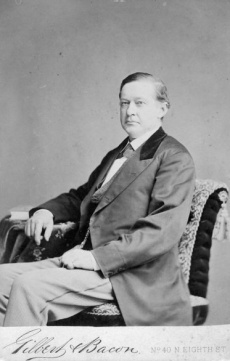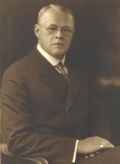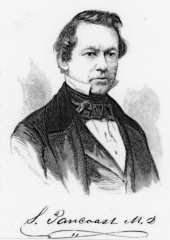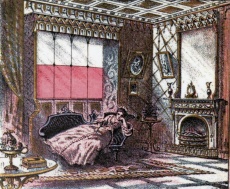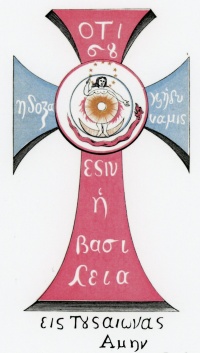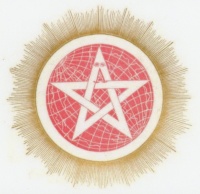Seth Pancoast: Difference between revisions
No edit summary |
No edit summary |
||
| (33 intermediate revisions by 2 users not shown) | |||
| Line 1: | Line 1: | ||
Dr. '''Seth Pancoast''', M.D., of Philadelphia was | [[File:Seth Pancoast engraving.png|right|200px|thumb|Dr. Seth Pancoast]] | ||
[[File:Seth Pancoast portrait.jpg|right|230px|thumb|Dr. Seth Pancoast]] | |||
'''Dr. Seth Pancoast''', M.D., of Philadelphia was a professor of medicine, mystic, and occultist. He was one of the [[Founding of the Theosophical Society|founding members]] of the [[Theosophical Society]]. | |||
According to [[Josephine Ransom]], | == Personal life and career == | ||
Seth Pancoast was born to Stephen and Ann Pancoast in Darby, Pennsylvania on [[July 28]], 1823.<ref>Darby Friends Cemetery records in U.S. Find A Grave Index.</ref><ref>Philadelphia Monthly Meeting, Births and Death, 1827-1903. U.S. Quaker Meeting Records.</ref> Stephen Pancoast was a paper manufacturer.<ref>Boris de Zirkoff, "Pancoast, Dr. Seth" ''H. P. Blavatsky Collected Writings'' Volume I (Wheaton, Illinois: Theosophical Press, 1966), 520.</ref><ref>Henry J Newton in the New York, New York, Extracted Death Index, 1862-1948.</ref> His was a Quaker family; he was descended from one of three Pancoast brothers who accompanied William Penn in establishing the colony of Pennsylvania.<ref>"Pancoast, Seth," ''Appletons' Cyclopedia of American Biography, 1600-1889 Volume IV'' (New York: D. Appleton & Company, 1889), 642. Available at [https://babel.hathitrust.org/cgi/pt?id=mdp.39076005094219;view=1up;seq=686 Hathitrust].</ref> | |||
After a classical education, Pancoast engaged in business in 1843, and then studied medicine at the University of Pennsylvania. He was graduated in 1852 and entered into medical practice in Philadelphia. | |||
[[File:Henry Khunrath Pancoast.jpg|120px|left|thumb|Henry Khunrath Pancoast]] | |||
He was married three times, to Sarah Saunders Osborn, Susan George Osborn, and finally, Carrie Almens Farnald.<ref>Boris de Zirkoff, 521.</ref> Pancoast had children by all three wives – at least five daughters and three sons, some of whom attended the Friends' Middle School. The middle son, '''Henry Khunrath Pancoast''', was born on February 26, 1875. His name must be a tribute to the great German alchemist Heinrich Khunrath (1560–1605) <ref>U.S. Census, 1860, 1870 and 1880.</ref> Henry followed his father into medical practice, and became a pioneer in the field of radiology. | |||
Dr. Seth Pancoast's personal library was described as "the finest private collection of works on the occult sciences in the United States."<ref>''Appletons' Cyclopedia'', 642.</ref> One example of the caliber of books in his collection was ''Cabala, Speculum Artis Et Naturae, in Alchemia'' printed by Andrea Erffurt in Augusburg Germany in 1654.<ref>Email to Janet Kerschner from a bookseller. December 5, 2016. Theosophical Society in America Archives.</ref> It is clear from Pancoast's literary references that he was familiar with the Latin, Greek, Hebrew, and German languages. | |||
The doctor died on [[December 16]], 1889 of heart disease and was buried in the Darby Friends Cemetery in Philadelphia.<ref>"Obituary Notice" | |||
''The Path'' 4.10 (January, 1890), 338.</ref><ref>Darby Friends Cemetery records in U.S. Find A Grave Index.</ref> | |||
Note: Another early member of the [[Theosophical Society]], '''Benjamin Franklin Pancoast''', seems not to have been related closely to Seth Pancoast. Benjamin was a tinsmith in Cambridge, Massachusetts who joined in Boston on May 12, 1894.<ref>Theosophical Society General Membership Register, 1875-1942 at [http://tsmembers.org/ http://tsmembers.org/]. See book 1, entry 11159 (website file: 1D/42).</ref> | |||
[[File:Seth Pancoast in 1855.jpg|right|170px|thumb|Dr. Pancoast, 1855]] | |||
== Medical career == | |||
After completing his medical education, the new doctor became a professor of anatomy in a "female college" in 1853, and the next year was named a professor of "Microscopic Anatomy and Physiology" at the Institute of Medicine at Penn Medical University in Philadelphia.<ref>Title page of his book ''The Ladies' Medical Guide'', 1865 sixth edition.</ref><ref>''Appletons' Cyclopedia, 642''</ref> After five years he entered private practice and was given emeritus status. He wrote medical books and articles, including one on the '''therapeutic qualities of the light spectrum'''. | |||
== Theosophical Society involvement == | |||
[[Henry Steel Olcott|Col. Olcott]] described Dr. Pancoast as "a most erudite Kabbalist". The doctor was present at the meeting of [[September 7]], 1875, that eventually led to the forming of the [[Theosophical Society]].<ref>Henry Steel Olcott, ''Old Diary Leaves'' First Series (Adyar, Madras: The Theosophical Publishing House, 1974), 116.</ref><ref>Theosophical Society General Membership Register, 1875-1942 at [http://tsmembers.org/ http://tsmembers.org/]. See book 1, entry unnumbered (website file: 1A/10).</ref> Although his name is not among the sixteen people that the next day met to form the Society, he was elected as '''Vice-President''' on the meeting held on [[October 30]], previous to the inaugural one on [[November 17]].<ref>Henry Steel Olcott, ''Old Diary Leaves'' First Series (Adyar, Madras: The Theosophical Publishing House, 1974), 135.</ref> | |||
He was among the Theosophists present at the [[cremation]] of [[Baron de Palm]] on [[December 6]], 1876. | |||
According to Theosophical historian [[Josephine Ransom]], | |||
<blockquote> | |||
DR. SETH PANCOAST, of Philadelphia, was a theistic mystic and a great alchemist... He was present at [[George H. Felt|Felt's]] lecture and questioned him closely. [[Helena Petrovna Blavatsky|H.P.B.]] always spoke with great respect of his erudition. But when it came to putting theory to the test by evoking the unseen elemental races which guard the threshold of knowledge, he confessed he lacked courage, though H.P.B. frequently offered to assist in the ceremonies and, if necessary, face the worst of the phantoms alone. Under the names of "Lex" and "Lex et Lux" he wrote for the [[Spiritualism|Spiritualistic]] papers on kabalistic and other matters. He remained a member till he passed away in 1889.<ref>Josephine Ransom, ''A Short History of the Theosophical Society'' (Adyar, India: Theosophical Publishing House, 1938), 113-114. Quoted from ''The Theosophist'' XIV (November, 1892), 72.</ref> | |||
</blockquote> | |||
== International Submarine Company == | |||
In 1877 Dr. Pancoast was involved in search efforts for the sunken British sloop of war, HMS ''Braak''. He founded the International Submarine Company that mounted an unsuccessful effort to locate the wreck.<ref> "Dr. Pancoast's Treasure-Hunt", ''The Scrap Book'' (Frank A. Munsey Co.) 5.4 (April, 1908), 718.</ref> | |||
== Occult predictions == | |||
A biographical sketch of Dr. Pancoast in ''Appletons' Cyclopedia'' described his predictions of a revival of interest in the occult: | |||
<blockquote> | |||
In 1875 Dr. Pancoast calculated the return of the seventh cycle of Trithemius in 1878, announcing that if the calculation were correct there would be a revival in theosophy and other occult studies, which has since occurred. His work was merely a prelude to a much larger one, which is now (1888) approaching completion. The formulation of the latter has required twenty years' search and selection through ancient works in European libraries.<ref>''Appletons' Cyclopedia'', 642.</ref> | |||
</blockquote> | |||
Whether this work was ever completed is not known. | |||
== Kabbalistic work == | |||
Dr. Pancoast studied [[Kabbalah]] deeply, within a Christian context. Some of his interpretations were unconventional, but altogether formed a cohesive system incorporating his Quaker understanding of the Inner Light.<ref>Julie Chajes, [https://www.academia.edu/31325628/Seth_Pancoast_and_the_Kabbalah_Medical_Pluralism_and_the_Reception_of_Physics_in_Late-Nineteenth_Century_Philadelphia_1 ''Seth Pancoast and the Kabbalah: Medical Pluralism and the Reception of Physics in Late Nineteenth Century Philadelphia''] on Academia.edu.</ref> | |||
His book '''''The Kabbalah: or, The True Science of Light; an Introduction to the Philosophy and Theosophy of the Ancient Sages''''' presented many kabbalistic concepts, but aimed to educate readers in the use of colored lights for healing. According to scholar Julie Chajes, | |||
[[File:Pancoast application of red light.jpg|left|230px|thumb|Application of red light in ''Kabbalah'']] | |||
<blockquote> | |||
He considered his Kabbalistic coloured light techniques – which were designed to restore equilibrium – especially efficacious in the treatment of diseases of the nervous system. Pancoast saw light as a mysterious, all-pervading, all-producing, all-controlling, all-invigorating power, indeed, the manifestation of God Himself. He argued there were two types of light: visible light and celestial light, which was the invisible power behind visible light. Celestial light | |||
was associated with the Kabbalistic [[Ain Soph|''En Soph'']], conceived by Pancoast as the source of all creation... | |||
[[File:Pancoast Kabbalah frontispiece.jpg|right|200px|thumb|Frontispiece from ''Kabbalah'']] | |||
[[File:Pancoast illustration.jpg|right|200px|thumb|Flaming Pentagram of the Ancients. From ''Kabbalah'', page 32.]] | |||
He claimed rays of light in these colours had curative effects that corresponded to the characteristics of the relevant ''sephirah''. Kabbalists, he claimed, understood these colours’ influence in light and in nature, their distinctive properties and their action together and separately. His methods involved the treatment of medicines with different coloured lights and the application of a coloured ‘sun bath’ to the patient through the use of coloured glass. Blue and red rays Pancoast considered especially curative.<ref>Julie Chajes.</ref> | |||
</blockquote> | |||
The '''frontispiece''' [right] of the volume is richly symbolic. It is a kabbalistic depiction of an Apocalyptic vision from St. John the Divine: | |||
<blockquote> | <blockquote> | ||
... John was a Kabbalist of a high order... he tells us of a most remarkable vision: "And there appeared a great wonder in heaven, a woman clothed with the sun, and the moon under her feet, and upon her head a crown of twelve stars," etc. The [[Rosicrucianism|Rosicrucians]] call the Light of the Celestial Sun the Divine ''Sophia'', "Wisdom," ... The Egyptian Kabbalists called this light ''Isis'', and represented ''Isis'' as a pure woman... they placed under the feet of ''Isis'' the Crescent, beneath which, but outside the sacred circle, was a vanquished Fiery Serpent; then as a token of the supremacy of ''Tipheroth'' in the universe, they surrounded the head of ''Isis'' with a halo of twelve Stars. | |||
<ref>Seth Pancoast, ''Kabbalah'' (Philadelphia: J. M. Stoddart & Co., 1877), 32-33.</ref> | |||
</blockquote> | </blockquote> | ||
In his unique version of this image, the circle is superimposed on a cross that says in Greek, "For Thine is the Kingdom, and the Power, and the Glory, Forever, Amen." | |||
In the '''Flaming Pentagram of the Ancients''' [right], the star that inspired the Eastern Wise Men of the Nativity story: | |||
<blockquote> | |||
"is shown within the Objective Sun, the Life-principle with the Objective Orb. The letter A represents its Duality in Unity, the line across uniting the divergent lines, and the angle at the top being the point of unity where they emanate from the "All-Seeing Eyes" of the Supreme.<ref>Seth Pancoast, 31, 246.</ref> | |||
</blockquote> | |||
Appleton's Cyclopedia, in its biographical sketch of Pancoast, recognized his book "''The Cabala''" as "the first book on the subject in the English language," although it is unclear whether the editor was referring to the work's kabbalistic content or its system of light therapy.<ref>"Pancoast, Seth" ''Appleton's Cyclopedia'', 642.</ref> | |||
This book was influential to early Theosophists, and was quoted by [[Helena Petrovna Blavatsky]] in the second volume of [[Isis Unveiled (book)|''Isis Unveiled'']]. An Indian Theosophist who devoted his life to light therapies, [[Dinshah Ghadiali]], was familiar with Pancoast's ideas.<ref>Pater Havasi, "Dinshah P. Ghadiali, Harry Oldfield" ''Education of Cancer Healing Vol. IX - The Best Of'' (Electronically published on Lulu, 2012), 38.</ref> | |||
== Writings == | |||
Dr. Pancoast's writings were well-researched in the scholarly languages of the day – Latin, Greek, Hebrew, and German. | |||
=== Occult and Theosophical works === | |||
Dr. Pancoast wrote [http://www.austheos.org.au/cgi-bin/ui-csvsearch.pl?search=Seth+Pancoast&method=all two articles] for [[The Path (periodical)|''The Path'']], according to the [[ Union Index of Theosophical Periodicals]], and he wrote for spiritualist periodicals as well under the pseudonyms "Lex" and "Lex et Lux." | |||
* '''[https://www.theosociety.org/pasadena/path/v01n01p08_kabbalah_seth-pancoast.htm "Kabbalah"]''', Originally printed in ''The Path'', April, 1886. | |||
* '''[https://www.theosociety.org/pasadena/path/v01n02p37_the-mystery-of-numbers.htm "The Mystery of Numbers"]'''. Originally printed in ''The Path'', May, 1886. | |||
* '''''[https://www.amazon.com/Kabbalah-Theosophy-Theosophical-Classics-Esoteric-ebook/dp/B01M6A6L72 Kabbalah and Theosophy: Two Essays: Theosophical Classics: Esoteric Studies]''''' is an electronic publication of the same essays. | |||
The doctor published only one occult work, in these editions: | |||
* '''''The Kabbalah: or, The True Science of Light; an Introduction to the Philosophy and Theosophy of the Ancient Sages'''''. Philadelphia: J. M. Stoddart & Co., 1877. 312 pages. Subtitled "Together with a Chapter on Light in the Vegetable Kingdom." The book was printed in blue with red line border, which is especially appropriate because this text provides instruction on the effects of red and blue lights in healing. Available at [https://books.google.com/books?id=LyE4AAAAMAAJ&pg=PA32-IA1&source=gbs_selected_pages&cad=2#v=onepage&q&f=false Google Books], [https://archive.org/details/kabbalatruescien00panc Internet Archive], and [http://www.iapsop.com/ssoc/1883__pancoast___kabbala_or_the_true_science_or_light.pdf IAPSOP]. | |||
* Apparently offered by the same publisher in 1877 as '''''Blue and Red Light, or, Light and Its Rays as Medicine'''''. Subtitled: showing that light is the original and sole source of life, as it is the source of all the physical and vital forces of nature, and that light is nature's own and only remedy for disease, and explaining how to apply the red and blue rays in curing the sick and feeble: together with a chapter on light in the vegetable kingdom." 312 pages. Available from [https://play.google.com/store/books/details?id=tgA1AQAAMAAJ&rdid=book-tgA1AQAAMAAJ&rdot=1 Google Books]. | |||
* Reprinted New York: R. Worthington, 1883. | |||
=== Medical works === | |||
* '''''Curability of Consumption'''''. Philadelphia, 1855. Available at [https://babel.hathitrust.org/cgi/pt?id=mdp.39015076940736;view=1up;seq=13 Hathitrust]. | |||
* '''''Boyhood's Perils and Man's Curse'''''. 1858 and 1860. Above the title in 1860 was printed '''''Startling Sexual Secrets!'''''. This work campaigning against masturbation carried the full title: ''Onanism, Spermatorrhoea: Porneio-Kalogynomia-Pathology; Boyhood's Perils and Manhood's Curse; An Earnest Appeal to the Young of America.'' | |||
* '''''What Is Bright's Disease? Its Curability'''''. Philadelphia, 1882. | |||
* '''''The Ladies' Medical Guide'''''. 1859. This popular work was published in many editions: | |||
** Philadelphia: John E. Potter, 1865. '''[https://babel.hathitrust.org/cgi/pt?id=miun.akk5515.0001.001 Sixth 1865 edition]''' available at Hathitrust and also at [https://quod.lib.umich.edu/cgi/t/text/text-idx?c=moa;idno=AKK5515 University of Michigan]. According the 1865 sixth edition, Dr. Pancoast applied for copyright in 1859. | |||
** Published 1869 under title: '''''The Ladies' Medical Guide and Marriage Friend'''''. Includes a portrait of the author. '''[https://wellcomelibrary.org/item/b20412010 1869 edition]''' available at Wellcome Library. 1875 edition was subtitled: "a complete instructor and counsellor, embracing a full and exhaustive account of the structure and functions of the reproductive organs, the diseases of females and children, with their causes, symptoms and treatment, the toilet considered in reference to female health, beauty and longevity, etc., etc., etc., with an appendix containing startling facts in plain words for mothers and the young." At 600 pages, with 122 engravings, this was for decades the most complete popular work of its type. The writing style was matter-of-fact, based in scientific evidence and never crude or sallacious. In addition to details of women's anatomy and physiology, the author discussed genetic predispositionssuggested remedies for numerous health problems, and included a lengthy chapter on hair styles. | |||
** Other editions were published in St. Louis and San Francisco. | |||
** From 1901-1905, at least nine editions were published posthumously under the name '''''Pancoast's Tokology and Ladies Medical Guide, A Complete Instructor in All the Delicate and Wonderful Matters Pertaining to Women'''''. Reproductions are still being printed. Dr. C. C. Vanderbeck was involved with some of the later editions. | |||
== Biographies and other resources == | |||
* Austin, Benjamin W. '''[https://cpparchives.org/repositories/2/resources/47 ''Autograph Collection, 1885-1894'']'''. "Collection assembled by Benjamin W. Austin as secretary of Trinity Historical Society, Dallas, Tex., 1885-1894, includes letters from physicians, several eclectic or homeopathic, accepting honorary or non-resident membership in society." | |||
* Chajes, Julia. [https://www.academia.edu/31325628/Seth_Pancoast_and_the_Kabbalah_Medical_Pluralism_and_the_Reception_of_Physics_in_Late-Nineteenth_Century_Philadelphia_1 '''''Seth Pancoast and the Kabbalah: Medical Pluralism and the Reception of Physics in Late Nineteenth Century Philadelphia'''''] on Academia.edu. | |||
* Herringshaw, Thomas William. '''"Pancoast, Seth"''' in '''''Herringshaw's national library of American biography: contains thirty-five thousand biographies of the acknowledged leaders of life and thought of the United States V4.'''''. Chicago: American Publishers' Association, 1914. Illustrated with three thousand vignette portraits. | |||
== Notes == | == Notes == | ||
| Line 13: | Line 120: | ||
[[Category:Founders|Pancoast, Seth]] | [[Category:Founders|Pancoast, Seth]] | ||
[[Category:Kabbalists|Pancoast, Seth]] | [[Category:Kabbalists|Pancoast, Seth]] | ||
[[Category:Mystics|Pancoast, Seth]] | |||
[[Category:Alchemists|Pancoast, Seth]] | [[Category:Alchemists|Pancoast, Seth]] | ||
[[Category:Healers|Pancoast, Seth]] | |||
[[Category:Physicians|Pancoast, Seth]] | [[Category:Physicians|Pancoast, Seth]] | ||
[[category:Educators|Pancoast, Seth]] | [[category:Educators|Pancoast, Seth]] | ||
[[Category:Writers|Pancoast, Seth]] | [[Category:Writers|Pancoast, Seth]] | ||
[[Category:Associates of HPB|Pancoast, Seth]] | [[Category:Associates of HPB|Pancoast, Seth]] | ||
[[Category:People|Pancoast, Seth]] | |||
Latest revision as of 18:34, 31 May 2020
Dr. Seth Pancoast, M.D., of Philadelphia was a professor of medicine, mystic, and occultist. He was one of the founding members of the Theosophical Society.
Personal life and career
Seth Pancoast was born to Stephen and Ann Pancoast in Darby, Pennsylvania on July 28, 1823.[1][2] Stephen Pancoast was a paper manufacturer.[3][4] His was a Quaker family; he was descended from one of three Pancoast brothers who accompanied William Penn in establishing the colony of Pennsylvania.[5]
After a classical education, Pancoast engaged in business in 1843, and then studied medicine at the University of Pennsylvania. He was graduated in 1852 and entered into medical practice in Philadelphia.
He was married three times, to Sarah Saunders Osborn, Susan George Osborn, and finally, Carrie Almens Farnald.[6] Pancoast had children by all three wives – at least five daughters and three sons, some of whom attended the Friends' Middle School. The middle son, Henry Khunrath Pancoast, was born on February 26, 1875. His name must be a tribute to the great German alchemist Heinrich Khunrath (1560–1605) [7] Henry followed his father into medical practice, and became a pioneer in the field of radiology.
Dr. Seth Pancoast's personal library was described as "the finest private collection of works on the occult sciences in the United States."[8] One example of the caliber of books in his collection was Cabala, Speculum Artis Et Naturae, in Alchemia printed by Andrea Erffurt in Augusburg Germany in 1654.[9] It is clear from Pancoast's literary references that he was familiar with the Latin, Greek, Hebrew, and German languages.
The doctor died on December 16, 1889 of heart disease and was buried in the Darby Friends Cemetery in Philadelphia.[10][11]
Note: Another early member of the Theosophical Society, Benjamin Franklin Pancoast, seems not to have been related closely to Seth Pancoast. Benjamin was a tinsmith in Cambridge, Massachusetts who joined in Boston on May 12, 1894.[12]
Medical career
After completing his medical education, the new doctor became a professor of anatomy in a "female college" in 1853, and the next year was named a professor of "Microscopic Anatomy and Physiology" at the Institute of Medicine at Penn Medical University in Philadelphia.[13][14] After five years he entered private practice and was given emeritus status. He wrote medical books and articles, including one on the therapeutic qualities of the light spectrum.
Theosophical Society involvement
Col. Olcott described Dr. Pancoast as "a most erudite Kabbalist". The doctor was present at the meeting of September 7, 1875, that eventually led to the forming of the Theosophical Society.[15][16] Although his name is not among the sixteen people that the next day met to form the Society, he was elected as Vice-President on the meeting held on October 30, previous to the inaugural one on November 17.[17]
He was among the Theosophists present at the cremation of Baron de Palm on December 6, 1876.
According to Theosophical historian Josephine Ransom,
DR. SETH PANCOAST, of Philadelphia, was a theistic mystic and a great alchemist... He was present at Felt's lecture and questioned him closely. H.P.B. always spoke with great respect of his erudition. But when it came to putting theory to the test by evoking the unseen elemental races which guard the threshold of knowledge, he confessed he lacked courage, though H.P.B. frequently offered to assist in the ceremonies and, if necessary, face the worst of the phantoms alone. Under the names of "Lex" and "Lex et Lux" he wrote for the Spiritualistic papers on kabalistic and other matters. He remained a member till he passed away in 1889.[18]
International Submarine Company
In 1877 Dr. Pancoast was involved in search efforts for the sunken British sloop of war, HMS Braak. He founded the International Submarine Company that mounted an unsuccessful effort to locate the wreck.[19]
Occult predictions
A biographical sketch of Dr. Pancoast in Appletons' Cyclopedia described his predictions of a revival of interest in the occult:
In 1875 Dr. Pancoast calculated the return of the seventh cycle of Trithemius in 1878, announcing that if the calculation were correct there would be a revival in theosophy and other occult studies, which has since occurred. His work was merely a prelude to a much larger one, which is now (1888) approaching completion. The formulation of the latter has required twenty years' search and selection through ancient works in European libraries.[20]
Whether this work was ever completed is not known.
Kabbalistic work
Dr. Pancoast studied Kabbalah deeply, within a Christian context. Some of his interpretations were unconventional, but altogether formed a cohesive system incorporating his Quaker understanding of the Inner Light.[21]
His book The Kabbalah: or, The True Science of Light; an Introduction to the Philosophy and Theosophy of the Ancient Sages presented many kabbalistic concepts, but aimed to educate readers in the use of colored lights for healing. According to scholar Julie Chajes,
He considered his Kabbalistic coloured light techniques – which were designed to restore equilibrium – especially efficacious in the treatment of diseases of the nervous system. Pancoast saw light as a mysterious, all-pervading, all-producing, all-controlling, all-invigorating power, indeed, the manifestation of God Himself. He argued there were two types of light: visible light and celestial light, which was the invisible power behind visible light. Celestial light was associated with the Kabbalistic En Soph, conceived by Pancoast as the source of all creation...
He claimed rays of light in these colours had curative effects that corresponded to the characteristics of the relevant sephirah. Kabbalists, he claimed, understood these colours’ influence in light and in nature, their distinctive properties and their action together and separately. His methods involved the treatment of medicines with different coloured lights and the application of a coloured ‘sun bath’ to the patient through the use of coloured glass. Blue and red rays Pancoast considered especially curative.[22]
The frontispiece [right] of the volume is richly symbolic. It is a kabbalistic depiction of an Apocalyptic vision from St. John the Divine:
... John was a Kabbalist of a high order... he tells us of a most remarkable vision: "And there appeared a great wonder in heaven, a woman clothed with the sun, and the moon under her feet, and upon her head a crown of twelve stars," etc. The Rosicrucians call the Light of the Celestial Sun the Divine Sophia, "Wisdom," ... The Egyptian Kabbalists called this light Isis, and represented Isis as a pure woman... they placed under the feet of Isis the Crescent, beneath which, but outside the sacred circle, was a vanquished Fiery Serpent; then as a token of the supremacy of Tipheroth in the universe, they surrounded the head of Isis with a halo of twelve Stars. [23]
In his unique version of this image, the circle is superimposed on a cross that says in Greek, "For Thine is the Kingdom, and the Power, and the Glory, Forever, Amen."
In the Flaming Pentagram of the Ancients [right], the star that inspired the Eastern Wise Men of the Nativity story:
"is shown within the Objective Sun, the Life-principle with the Objective Orb. The letter A represents its Duality in Unity, the line across uniting the divergent lines, and the angle at the top being the point of unity where they emanate from the "All-Seeing Eyes" of the Supreme.[24]
Appleton's Cyclopedia, in its biographical sketch of Pancoast, recognized his book "The Cabala" as "the first book on the subject in the English language," although it is unclear whether the editor was referring to the work's kabbalistic content or its system of light therapy.[25]
This book was influential to early Theosophists, and was quoted by Helena Petrovna Blavatsky in the second volume of Isis Unveiled. An Indian Theosophist who devoted his life to light therapies, Dinshah Ghadiali, was familiar with Pancoast's ideas.[26]
Writings
Dr. Pancoast's writings were well-researched in the scholarly languages of the day – Latin, Greek, Hebrew, and German.
Occult and Theosophical works
Dr. Pancoast wrote two articles for The Path, according to the Union Index of Theosophical Periodicals, and he wrote for spiritualist periodicals as well under the pseudonyms "Lex" and "Lex et Lux."
- "Kabbalah", Originally printed in The Path, April, 1886.
- "The Mystery of Numbers". Originally printed in The Path, May, 1886.
- Kabbalah and Theosophy: Two Essays: Theosophical Classics: Esoteric Studies is an electronic publication of the same essays.
The doctor published only one occult work, in these editions:
- The Kabbalah: or, The True Science of Light; an Introduction to the Philosophy and Theosophy of the Ancient Sages. Philadelphia: J. M. Stoddart & Co., 1877. 312 pages. Subtitled "Together with a Chapter on Light in the Vegetable Kingdom." The book was printed in blue with red line border, which is especially appropriate because this text provides instruction on the effects of red and blue lights in healing. Available at Google Books, Internet Archive, and IAPSOP.
- Apparently offered by the same publisher in 1877 as Blue and Red Light, or, Light and Its Rays as Medicine. Subtitled: showing that light is the original and sole source of life, as it is the source of all the physical and vital forces of nature, and that light is nature's own and only remedy for disease, and explaining how to apply the red and blue rays in curing the sick and feeble: together with a chapter on light in the vegetable kingdom." 312 pages. Available from Google Books.
- Reprinted New York: R. Worthington, 1883.
Medical works
- Curability of Consumption. Philadelphia, 1855. Available at Hathitrust.
- Boyhood's Perils and Man's Curse. 1858 and 1860. Above the title in 1860 was printed Startling Sexual Secrets!. This work campaigning against masturbation carried the full title: Onanism, Spermatorrhoea: Porneio-Kalogynomia-Pathology; Boyhood's Perils and Manhood's Curse; An Earnest Appeal to the Young of America.
- What Is Bright's Disease? Its Curability. Philadelphia, 1882.
- The Ladies' Medical Guide. 1859. This popular work was published in many editions:
- Philadelphia: John E. Potter, 1865. Sixth 1865 edition available at Hathitrust and also at University of Michigan. According the 1865 sixth edition, Dr. Pancoast applied for copyright in 1859.
- Published 1869 under title: The Ladies' Medical Guide and Marriage Friend. Includes a portrait of the author. 1869 edition available at Wellcome Library. 1875 edition was subtitled: "a complete instructor and counsellor, embracing a full and exhaustive account of the structure and functions of the reproductive organs, the diseases of females and children, with their causes, symptoms and treatment, the toilet considered in reference to female health, beauty and longevity, etc., etc., etc., with an appendix containing startling facts in plain words for mothers and the young." At 600 pages, with 122 engravings, this was for decades the most complete popular work of its type. The writing style was matter-of-fact, based in scientific evidence and never crude or sallacious. In addition to details of women's anatomy and physiology, the author discussed genetic predispositionssuggested remedies for numerous health problems, and included a lengthy chapter on hair styles.
- Other editions were published in St. Louis and San Francisco.
- From 1901-1905, at least nine editions were published posthumously under the name Pancoast's Tokology and Ladies Medical Guide, A Complete Instructor in All the Delicate and Wonderful Matters Pertaining to Women. Reproductions are still being printed. Dr. C. C. Vanderbeck was involved with some of the later editions.
Biographies and other resources
- Austin, Benjamin W. Autograph Collection, 1885-1894. "Collection assembled by Benjamin W. Austin as secretary of Trinity Historical Society, Dallas, Tex., 1885-1894, includes letters from physicians, several eclectic or homeopathic, accepting honorary or non-resident membership in society."
- Chajes, Julia. Seth Pancoast and the Kabbalah: Medical Pluralism and the Reception of Physics in Late Nineteenth Century Philadelphia on Academia.edu.
- Herringshaw, Thomas William. "Pancoast, Seth" in Herringshaw's national library of American biography: contains thirty-five thousand biographies of the acknowledged leaders of life and thought of the United States V4.. Chicago: American Publishers' Association, 1914. Illustrated with three thousand vignette portraits.
Notes
- ↑ Darby Friends Cemetery records in U.S. Find A Grave Index.
- ↑ Philadelphia Monthly Meeting, Births and Death, 1827-1903. U.S. Quaker Meeting Records.
- ↑ Boris de Zirkoff, "Pancoast, Dr. Seth" H. P. Blavatsky Collected Writings Volume I (Wheaton, Illinois: Theosophical Press, 1966), 520.
- ↑ Henry J Newton in the New York, New York, Extracted Death Index, 1862-1948.
- ↑ "Pancoast, Seth," Appletons' Cyclopedia of American Biography, 1600-1889 Volume IV (New York: D. Appleton & Company, 1889), 642. Available at Hathitrust.
- ↑ Boris de Zirkoff, 521.
- ↑ U.S. Census, 1860, 1870 and 1880.
- ↑ Appletons' Cyclopedia, 642.
- ↑ Email to Janet Kerschner from a bookseller. December 5, 2016. Theosophical Society in America Archives.
- ↑ "Obituary Notice" The Path 4.10 (January, 1890), 338.
- ↑ Darby Friends Cemetery records in U.S. Find A Grave Index.
- ↑ Theosophical Society General Membership Register, 1875-1942 at http://tsmembers.org/. See book 1, entry 11159 (website file: 1D/42).
- ↑ Title page of his book The Ladies' Medical Guide, 1865 sixth edition.
- ↑ Appletons' Cyclopedia, 642
- ↑ Henry Steel Olcott, Old Diary Leaves First Series (Adyar, Madras: The Theosophical Publishing House, 1974), 116.
- ↑ Theosophical Society General Membership Register, 1875-1942 at http://tsmembers.org/. See book 1, entry unnumbered (website file: 1A/10).
- ↑ Henry Steel Olcott, Old Diary Leaves First Series (Adyar, Madras: The Theosophical Publishing House, 1974), 135.
- ↑ Josephine Ransom, A Short History of the Theosophical Society (Adyar, India: Theosophical Publishing House, 1938), 113-114. Quoted from The Theosophist XIV (November, 1892), 72.
- ↑ "Dr. Pancoast's Treasure-Hunt", The Scrap Book (Frank A. Munsey Co.) 5.4 (April, 1908), 718.
- ↑ Appletons' Cyclopedia, 642.
- ↑ Julie Chajes, Seth Pancoast and the Kabbalah: Medical Pluralism and the Reception of Physics in Late Nineteenth Century Philadelphia on Academia.edu.
- ↑ Julie Chajes.
- ↑ Seth Pancoast, Kabbalah (Philadelphia: J. M. Stoddart & Co., 1877), 32-33.
- ↑ Seth Pancoast, 31, 246.
- ↑ "Pancoast, Seth" Appleton's Cyclopedia, 642.
- ↑ Pater Havasi, "Dinshah P. Ghadiali, Harry Oldfield" Education of Cancer Healing Vol. IX - The Best Of (Electronically published on Lulu, 2012), 38.

